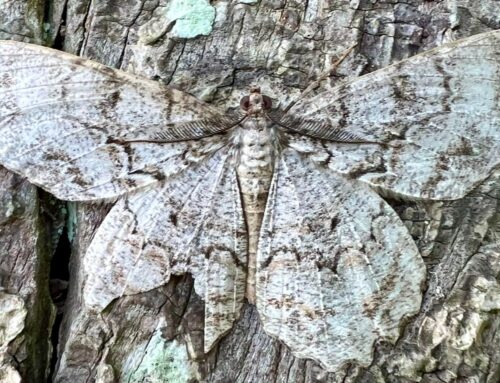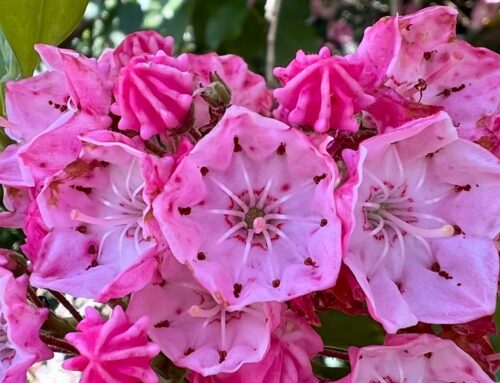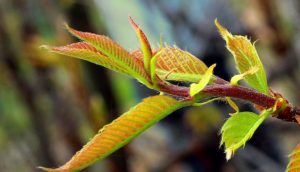
Do you remember the Longfellow poem which begins “Under a spreading chestnut tree the village smithy stands”? Everyone reading this poem when it was written in 1842 would have recognized a chestnut tree. At the time, billions of American chestnut trees dominated east coast forests from Maine to northern Florida and west into Tennessee and Ohio. These trees grew up to 100 feet tall and 9 feet around. It was estimated that one in every four trees was a chestnut. But when was the last time you saw a chestnut tree? Although there aren’t many blacksmiths around anymore either, I’ve seen blacksmiths, but not a chestnut tree.
Containing twice the amount of starch as a potato, chestnuts were an important source of food for many forest animals, including deer, turkey, and bear. Farmers would sometimes let their cows and pigs into the forest to forage for the nuts. People also ate chestnuts, which they not only roasted but ground into flour to make bread, cakes, and puddings. My grandmother told me stories of how she and her friends would make a day of gathering chestnuts in the forest. Harvested in the fall, chestnuts were often part of holiday feasts. The wood was very valuable because it was not only strong, but contained a fairly large amount of tannic acid, which caused it to resist rot. This made it ideal for cabins, shingles, fence posts, and telephone poles. Today we are generally required to use chemically-infused pressure treated wood for these outdoor projects. An important contributor to the economy, an estimate in 1910 valued American chestnut trees at $400,000,000. Unfortunately, the chestnut trees’ glory days were about to come to an end.
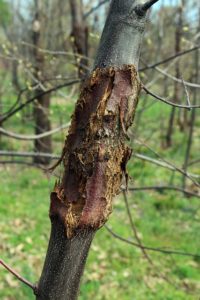
What could happen that would destroy this iconic American tree? A fungus imported from Asia was first spotted in 1904 in the New York Botanical Garden. It attacked American chestnuts, which had no resistance to this blight. The fungus infected the trees through cracks in the bark, developing a canker. This canker ate through the tree’s vascular system, preventing it from transporting the food it makes in its leaves through photosynthesis. Within 10 years the tree is dead. Although the fungus kills the tree, the roots are still alive. The roots send up shoots that start to grow, but eventually are infected by the blight and die back to the ground.
By the 1910s, people were desperately trying to control the blight. Farmers were urged to cut down trees that had any signs of infection. Even Boy Scouts tramped through forests looking for blighted trees. Scientists, governments, and the public weren’t enough. In 1920, The Bismarck Daily Tribune wrote, “Efforts to stop the spread of this bark disease has been given up.” By the 1950s, the American chestnut was essentially gone.
Although the fungus was not able to be controlled, researchers have been working on various ways to bring back the American chestnut. Several universities with help from nonprofit agencies, like the American Chestnut Foundation, are crossbreeding American chestnut trees with blight-resistant Chinese chestnut trees. Some geneticists are manipulating the genetic structure of the tree by adding blight-resistant genes. Progress is being made, but much more effort will be required before a fully blight-resistant American chestnut is produced.
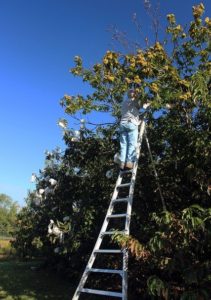
We are fortunate that Tyler Arboretum, in cooperation with Penn State and The Pennsylvania American Chestnut Foundation among others, is contributing to the scientific study of chestnut trees. The Chestnut Orchard at Tyler was started in 1997 and is among 100 chestnut orchards in Pennsylvania. Led by Dan O’Keefe, a team of volunteers tends to the chestnut orchard. In addition to maintaining the orchards through mulching and cutting out dead wood, the volunteers harvest the nuts. These are sent to refrigerators at Penn State to be chilled before germination. Records are kept on the “mother tree” and how effective pollination has been. Young trees are also inoculated to measure blight resistance.
The Tyler orchard was the first American chestnut germplasm preserve orchard established in Pennsylvania. In the past few years we have been expanding the work started by John Wenderoth to conserve more of the local diversity of the American chestnut, by collecting pollen from the rare large surviving American chestnut trees in Southeast Pennsylvania and Northern Delaware, using this pollen to make crosses with the trees in the Tyler orchard, and then repopulating the orchard with the trees that come from these crosses, giving us new trees with well-defined pedigrees. “So our volunteers are directly involved in the important work of conservation, in addition to the more routine maintenance of the trees in the orchard,” says Dan O’Keefe, head of the Chestnut Orchard Volunteers.
It’s a slow process. It takes six years for a Chestnut Tree to mature enough to set seed. But with Dan O’Keefe and the team of volunteers here at Tyler, we are hopeful for the future.





